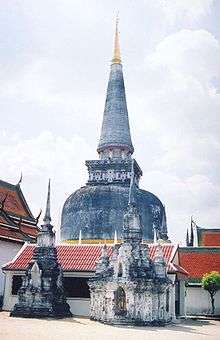Chandrabhanu
| Chandrabhanu Sridhamaraja | |
|---|---|
| King of Tambralinga | |
| Reign | 1230–1263 |
| Coronation | 1230 |
| Successor | Savakanmaindan |
| King of Jaffna | |
| Reign | 1255–1263 |
| Successor | Savakanmaindan |
| Born | Tambralinga |
| House | Savakan Lotus Dynasty |
| Religion | Buddhism |

Chandrabhanu (died 1263) or Chandrabhanu Sridhamaraja was the King of Tambralinga Kingdom in present-day Thailand. A Javaka, he was known to have ruled from during the period of 1230 until 1263. He was also known for building a well-known Buddhist stupa in southern Thailand. He spent more than 30 years in his attempt to conquer Sri Lanka. He was eventually defeated by the forces of the Pandyan Dynasty from Tamil Nadu (in present-day South India) in 1263 and was killed by the brother of the south Indian Emperor Jatavarman Sundara Pandyan.[1]
In 1247 he sent an expedition to the island ostensibly to acquire the Buddhist relic from the island.[2]:184–185 His forces, using poison darts, were able to occupy the Jaffna kingdom, the northern part of the island in 1255. Repeated attempts to conquer the rest of the island ensued. In 1258 his forces faced an invasion of the island by the forces of the Pandyan Dynasty commanded by Jatavarman Sundara Pandyan I, and Chandrabhanu submitted to Pandyan rule, bringing the Jaffna kingdom under Pandyan suzerainty. From 1262-1264 Tambralinga forces, using Chola and Pandyan soldiers commanded by Chandrabhanu's son Savakanmaindan and two Sinhalese princes were defeated by the Pandyans led in the invasion by Jatavarman Vira Pandyan I. In 1270, Savakanmaindan, kept on the Jaffna throne under Pandyan suzerainty attempted to invade the south of the island once again, and was defeated decisively by the Pandyans under Maravarman Kulasekara Pandyan I by the late 1270s. The defeat was so complete that in 1290, Tambralinga was absorbed by the neighboring Thai Kingdoms.[3]
Tambralinga
According to the inscription no.24 found at wat Hua-wieng (Hua-wieng temple) in Chaiya near to Nakhon Si Thammaraj, Chandrabhanu is a ruler of Tambralinga and was of Patama vamsa (lotus dynasty). He began to reign in 1230, he had built the Phrae Boromadhatu a buddhist stupa in Nakhon Si Thammaraj to hold the Buddha's relic.[4]
First invasion of Sri Lanka
It was recorded by the Mahawamsa, the historic chronicle of Sri Lanka to have invaded Sri Lanka in 1247 in search of Buddha's relict that Sri Lanka already had. According to Sri Lankan sources he was a Javaka chieftain and a sea pirate from the kingdom of Tambralinga. Although King Parakramabahu II (1236–70) from the Sinhalese Kingdom of Dambadeniya was able to defeat him, Chandrabhanu moved north and secured the Tamil throne for himself around 1255. Jatavarman Sundara Pandyan of the Pandyan Empire in Tamilakkam intervened in 1258 and made Chandrabhanu submit to Pandyan rule, annually offering precious jewels and elephants in tribute. A second attempt by Chandrabhanu to invade from the north prompted the south Indian Prince Jatavarman Veera Pandyan, brother of emperor Jatavarman Sundara Pandyan to intervene in 1262-1264. Chandrabhanu was killed in the battle. Veera Pandyan proceeded to plant the Pandyan bull victory flag at Koneswaram temple, Konamalai.[3] Savakanmaindan, son of Chandrabhanu, inherited the northern Tamil throne upon his father's death.
Chandrabhanu's son
Chandrabhanu's son Savakanmaindan submitted to Pandyan rule and was rewarded, he was allowed to retain control of the Jaffna kingdom while Sundara Pandyan remained supreme emperor of Pandyan. Marco Polo, describing Sundara Pandyan's empire as the richest in the world, visited the Jaffna kingdom upon docking at Trincomalee, and described the locals under king Sendemain's rule as mostly naked and feeding on rice and meat. The land was abundant with rubies and other precious stones, although by this stage Savakanmaindan had stopped paying tributes to the Pandyans. When Savakamaindan embarked on an invasion of the south, the Pandyan Dynasty under King Maravarman Kulasekara Pandyan I again invaded and defeated his forces in the late 1270s. However, to further the power of Tamil hard power in the region,[5] they eventually installed one of their ministers in charge of the invasion, Kulasekara Cinkaiariyan, an Aryacakravarti as the King.[6][7] In the local Tamil language, all South East Asians are known as Javar or Javanese. There are number of place names in the Jaffna peninsula which pertains to its South East Asian connections. Chavakacheri means a Javanese settlement. Chavahakottai means a Javanese fort all alluding to Chandrabhanu's brief rule in the north.[8]
Notes
- ↑ India's interaction with Southeast Asia,by Govind Chandra Pande p.286
- ↑ Cœdès, George (1968). The Indianized states of Southeast Asia. University of Hawaii Press. ISBN 9780824803681.
- 1 2 Bennett, Mathew The Hutchinson Dictionary of Ancient and Mediaeval warfare, p.100
- ↑ Liyanage, A. The Decline of Polonnaruwa and the rise of Dambadeniya, (Colombo, 1968) p.136; Recuil des Inscriptions du Siam II, 26, tr.27.
- ↑ deSilva 67
- ↑ de Silva, A History of Sri Lanka, p.91-92
- ↑ Kunarasa, K The Jaffna Dynasty, p.#
- ↑ Codrington, Humphry William. "Short history of Sri Lanka:Dambadeniya and Gampola Kings (1215-1411)". Lakdiva.org. Retrieved 2007-11-25.
References
- de Silva, K. M. (2005). A History of Sri Lanka. Colombo: Vijitha Yapa. p. 782. ISBN 955-8095-92-3.
- Kunarasa, K (2003). The Jaffna Dynasty. Johor Bahru: Dynasty of Jaffna King's Historical Society. p. 122. ISBN 955-8455-00-8.
External links
| Preceded by Unknown |
Tambralinga 1230–1270 |
Succeeded by Ramkhamhaeng? |
| Preceded by Kalinga Magha |
Jaffna Kingdom 1253–1270 |
Succeeded by Kulasekara Singaiariyan |